自动化专业英语教程翻译2.1
自动化专业英语
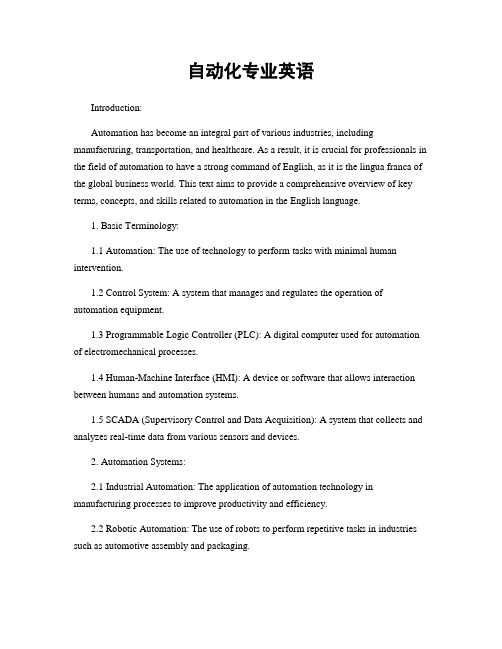
自动化专业英语Introduction:Automation has become an integral part of various industries, including manufacturing, transportation, and healthcare. As a result, it is crucial for professionals in the field of automation to have a strong command of English, as it is the lingua franca of the global business world. This text aims to provide a comprehensive overview of key terms, concepts, and skills related to automation in the English language.1. Basic Terminology:1.1 Automation: The use of technology to perform tasks with minimal human intervention.1.2 Control System: A system that manages and regulates the operation of automation equipment.1.3 Programmable Logic Controller (PLC): A digital computer used for automation of electromechanical processes.1.4 Human-Machine Interface (HMI): A device or software that allows interaction between humans and automation systems.1.5 SCADA (Supervisory Control and Data Acquisition): A system that collects and analyzes real-time data from various sensors and devices.2. Automation Systems:2.1 Industrial Automation: The application of automation technology in manufacturing processes to improve productivity and efficiency.2.2 Robotic Automation: The use of robots to perform repetitive tasks in industries such as automotive assembly and packaging.2.3 Process Automation: The automation of chemical, oil, and gas processes to enhance safety and accuracy.2.4 Home Automation: The integration of technology to control and monitor household devices and systems.3. Automation Techniques:3.1 Sensor Technology: Devices that detect and measure physical quantities such as temperature, pressure, and proximity.3.2 Actuators: Devices that convert electrical signals into mechanical motion, such as motors and solenoids.3.3 Feedback Control: A control technique that uses sensors to measure the output ofa system and adjust it accordingly.3.4 Artificial Intelligence (AI): The simulation of human intelligence in machines to perform tasks autonomously.3.5 Machine Learning: A subset of AI that enables machines to learn from data and improve their performance without explicit programming.4. Industrial Applications:4.1 Automotive Industry: Automation is extensively used in car manufacturing, including assembly line robots and quality control systems.4.2 Pharmaceutical Industry: Automation ensures precise dosage and packaging in pharmaceutical production.4.3 Food and Beverage Industry: Automation optimizes food processing, packaging, and quality control processes.4.4 Energy Sector: Automation is crucial in power plant operations, grid management, and renewable energy systems.4.5 Healthcare Industry: Automation is utilized in medical imaging, patient monitoring, and laboratory analysis.5. Skills for Automation Professionals:5.1 Programming: Proficiency in programming languages such as C++, Python, and ladder logic for PLC programming.5.2 Data Analysis: Ability to analyze and interpret data collected from automation systems using statistical methods and software tools.5.3 Troubleshooting: Expertise in identifying and resolving issues in automation systems, including hardware and software components.5.4 Project Management: Skills to plan, execute, and monitor automation projects, ensuring timely completion and adherence to budget.5.5 Communication: Effective communication skills to collaborate with cross-functional teams and articulate technical concepts to non-technical stakeholders.Conclusion:Automation plays a pivotal role in today's industries, and proficiency in English is essential for professionals in the field. This text has provided a comprehensive overview of key terms, concepts, and skills related to automation in the English language. By mastering these aspects, automation professionals can enhance their communication, expand their knowledge, and contribute to the advancement of automation technology.。
自动化专业英语原文和翻译
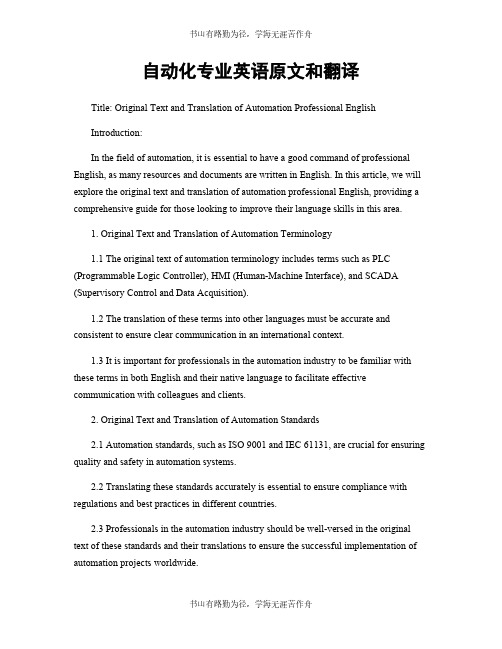
自动化专业英语原文和翻译Title: Original Text and Translation of Automation Professional EnglishIntroduction:In the field of automation, it is essential to have a good command of professional English, as many resources and documents are written in English. In this article, we will explore the original text and translation of automation professional English, providing a comprehensive guide for those looking to improve their language skills in this area.1. Original Text and Translation of Automation Terminology1.1 The original text of automation terminology includes terms such as PLC (Programmable Logic Controller), HMI (Human-Machine Interface), and SCADA (Supervisory Control and Data Acquisition).1.2 The translation of these terms into other languages must be accurate and consistent to ensure clear communication in an international context.1.3 It is important for professionals in the automation industry to be familiar with these terms in both English and their native language to facilitate effective communication with colleagues and clients.2. Original Text and Translation of Automation Standards2.1 Automation standards, such as ISO 9001 and IEC 61131, are crucial for ensuring quality and safety in automation systems.2.2 Translating these standards accurately is essential to ensure compliance with regulations and best practices in different countries.2.3 Professionals in the automation industry should be well-versed in the original text of these standards and their translations to ensure the successful implementation of automation projects worldwide.3. Original Text and Translation of Automation Documentation3.1 Automation documentation, including user manuals, technical specifications, and maintenance guides, is often written in English.3.2 Translating this documentation accurately is essential to ensure that users and technicians can understand and operate automation systems effectively.3.3 Professionals in the automation industry should be proficient in both the original text and translated versions of documentation to facilitate training, troubleshooting, and maintenance of automation systems.4. Original Text and Translation of Automation Research Papers4.1 Research papers on automation topics are often published in English-language journals and conferences.4.2 Translating these papers accurately is crucial for sharing knowledge and advancements in the field of automation with a global audience.4.3 Professionals in the automation industry should be able to read and understand original research papers in English and be familiar with translations in other languages to stay informed about the latest developments in the field.5. Original Text and Translation of Automation Software5.1 Automation software, such as CAD (Computer-Aided Design) and CAM (Computer-Aided Manufacturing) programs, often have interfaces and documentation in English.5.2 Translating this software accurately is essential for ensuring that engineers and technicians can use these tools effectively.5.3 Professionals in the automation industry should be proficient in both the original text and translated versions of automation software to maximize their productivity and efficiency in their work.Conclusion:In conclusion, having a good command of professional English in the field of automation is essential for effective communication, compliance with standards, and staying informed about the latest developments. By understanding the original text and translations of automation terminology, standards, documentation, research papers, and software, professionals in the industry can enhance their language skills and excel in their careers.。
自动化专业英语课程第二版翻译
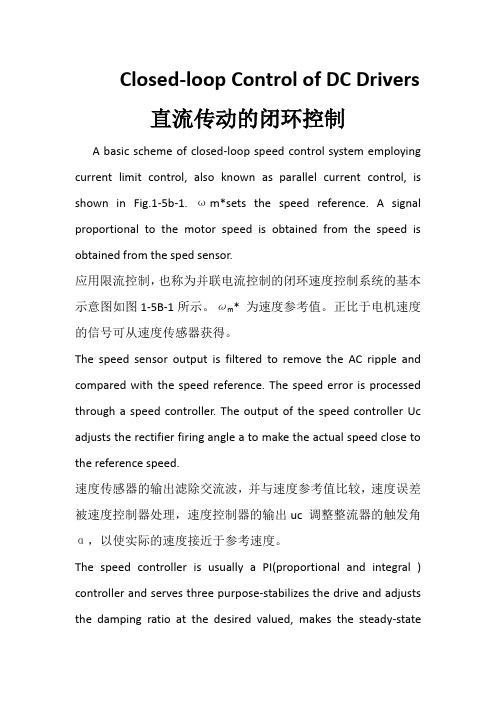
Closed-loop Control of DC Drivers 直流传动的闭环控制A basic scheme of closed-loop speed control system employing current limit control, also known as parallel current control, is shown in Fig.1-5b-1. ωm*sets the speed reference. A signal proportional to the motor speed is obtained from the speed is obtained from the sped sensor.应用限流控制,也称为并联电流控制的闭环速度控制系统的基本示意图如图1-5B-1所示。
ωm* 为速度参考值。
正比于电机速度的信号可从速度传感器获得。
The speed sensor output is filtered to remove the AC ripple and compared with the speed reference. The speed error is processed through a speed controller. The output of the speed controller Uc adjusts the rectifier firing angle a to make the actual speed close to the reference speed.速度传感器的输出滤除交流波,并与速度参考值比较,速度误差被速度控制器处理,速度控制器的输出uc 调整整流器的触发角α,以使实际的速度接近于参考速度。
The speed controller is usually a PI(proportional and integral ) controller and serves three purpose-stabilizes the drive and adjusts the damping ratio at the desired valued, makes the steady-statespeed-error close to zero by integral action, and filters out noise again due to the integral action.速度控制器通常是PI (比例积分)控制器,具有三种作用——稳定驱动,调整阻尼比到期望值;通过积分作用,使稳态速度误差接近于零;还是由于积分作用,可滤除噪音The drive employs current limit control, the purpose of which is to prevent the current from exceeding safe values. As long as Ia<Ix, where Ix is the maximum permissible value of Ia, the current control loop does not affect the drive operation.传动装置采用限流控制,其目的在于防止电流超出安全值。
自动化专业英语全文翻译
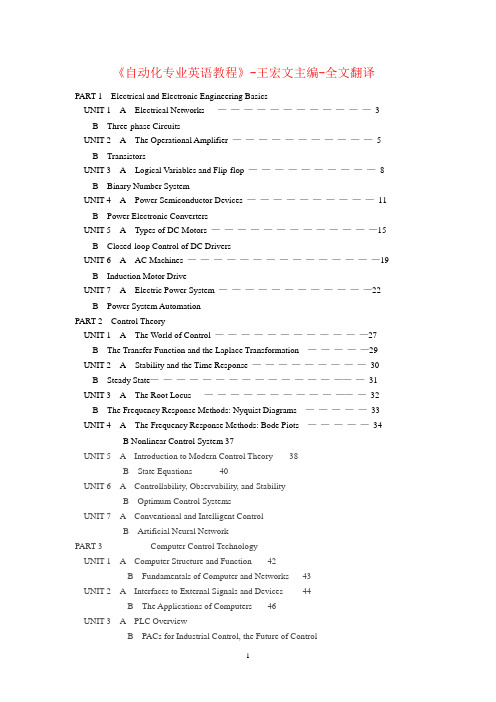
《自动化专业英语教程》-王宏文主编-全文翻译PART 1Electrical and Electronic Engineering BasicsUNIT 1A Electrical Networks ————————————3B Three-phase CircuitsUNIT 2A The Operational Amplifier ———————————5B TransistorsUNIT 3A Logical Variables and Flip-flop ——————————8B Binary Number SystemUNIT 4A Power Semiconductor Devices ——————————11B Power Electronic ConvertersUNIT 5A Types of DC Motors —————————————15B Closed-loop Control of DC DriversUNIT 6A AC Machines ———————————————19B Induction Motor DriveUNIT 7A Electric Power System ————————————22B Power System AutomationPART 2Control TheoryUNIT 1A The World of Control ————————————27B The Transfer Function and the Laplace Transformation —————29 UNIT 2A Stability and the Time Response —————————30B Steady State—————————————————31 UNIT 3A The Root Locus —————————————32B The Frequency Response Methods: Nyquist Diagrams —————33 UNIT 4A The Frequency Response Methods: Bode Piots —————34B Nonlinear Control System 37UNIT 5 A Introduction to Modern Control Theory 38B State Equations 40UNIT 6 A Controllability, Observability, and StabilityB Optimum Control SystemsUNIT 7 A Conventional and Intelligent ControlB Artificial Neural NetworkPART 3 Computer Control TechnologyUNIT 1 A Computer Structure and Function 42B Fundamentals of Computer and Networks 43UNIT 2 A Interfaces to External Signals and Devices 44B The Applications of Computers 46UNIT 3 A PLC OverviewB PACs for Industrial Control, the Future of ControlUNIT 4 A Fundamentals of Single-chip Microcomputer 49B Understanding DSP and Its UsesUNIT 5 A A First Look at Embedded SystemsB Embedded Systems DesignPART 4 Process ControlUNIT 1 A A Process Control System 50B Fundamentals of Process Control 52UNIT 2 A Sensors and Transmitters 53B Final Control Elements and ControllersUNIT 3 A P Controllers and PI ControllersB PID Controllers and Other ControllersUNIT 4 A Indicating InstrumentsB Control PanelsPART 5 Control Based on Network and InformationUNIT 1 A Automation Networking Application AreasB Evolution of Control System ArchitectureUNIT 2 A Fundamental Issues in Networked Control SystemsB Stability of NCSs with Network-induced DelayUNIT 3 A Fundamentals of the Database SystemB Virtual Manufacturing—A Growing Trend in AutomationUNIT 4 A Concepts of Computer Integrated ManufacturingB Enterprise Resources Planning and BeyondPART 6 Synthetic Applications of Automatic TechnologyUNIT 1 A Recent Advances and Future Trends in Electrical Machine DriversB System Evolution in Intelligent BuildingsUNIT 2 A Industrial RobotB A General Introduction to Pattern RecognitionUNIT 3 A Renewable EnergyB Electric VehiclesUNIT 1A 电路电路或电网络由以某种方式连接的电阻器、电感器和电容器等元件组成。
自动化专业英语原文和翻译
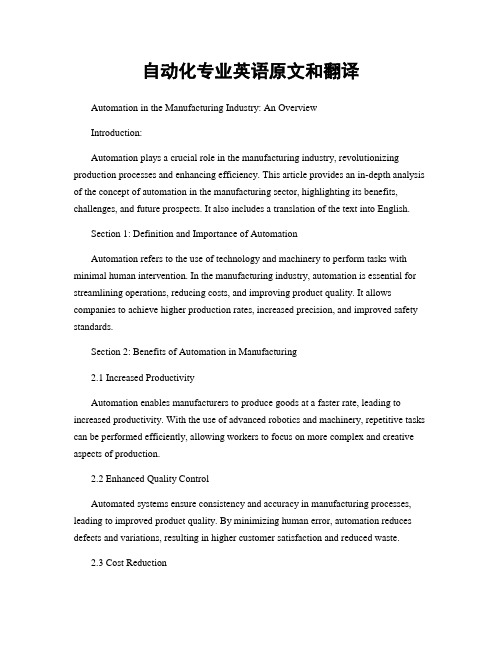
自动化专业英语原文和翻译Automation in the Manufacturing Industry: An OverviewIntroduction:Automation plays a crucial role in the manufacturing industry, revolutionizing production processes and enhancing efficiency. This article provides an in-depth analysis of the concept of automation in the manufacturing sector, highlighting its benefits, challenges, and future prospects. It also includes a translation of the text into English.Section 1: Definition and Importance of AutomationAutomation refers to the use of technology and machinery to perform tasks with minimal human intervention. In the manufacturing industry, automation is essential for streamlining operations, reducing costs, and improving product quality. It allows companies to achieve higher production rates, increased precision, and improved safety standards.Section 2: Benefits of Automation in Manufacturing2.1 Increased ProductivityAutomation enables manufacturers to produce goods at a faster rate, leading to increased productivity. With the use of advanced robotics and machinery, repetitive tasks can be performed efficiently, allowing workers to focus on more complex and creative aspects of production.2.2 Enhanced Quality ControlAutomated systems ensure consistency and accuracy in manufacturing processes, leading to improved product quality. By minimizing human error, automation reduces defects and variations, resulting in higher customer satisfaction and reduced waste.2.3 Cost ReductionAutomation helps in reducing labor costs by replacing manual work with machines and robots. Although initial investment costs may be high, long-term savings are significant due to increased efficiency and reduced dependence on human labor.2.4 Improved Workplace SafetyAutomation eliminates the need for workers to perform hazardous or physically demanding tasks. Robots and machines can handle tasks that pose risks to human health and safety, thereby reducing workplace accidents and injuries.2.5 Increased FlexibilityAutomated systems can be easily reprogrammed to adapt to changing production requirements. This flexibility allows manufacturers to respond quickly to market demands, introduce new products, and customize production processes.Section 3: Challenges in Implementing Automation3.1 Initial InvestmentImplementing automation requires substantial capital investment for purchasing and integrating machinery, software, and training. Small and medium-sized enterprises (SMEs) may face financial constraints in adopting automation technologies.3.2 Workforce AdaptationAutomation may lead to job displacement, as certain tasks previously performed by humans are now handled by machines. Companies need to provide training and re-skilling opportunities to ensure a smooth transition for their workforce.3.3 Technical ComplexityAutomation systems often involve complex integration of various technologies, such as robotics, artificial intelligence, and data analytics. Companies must have skilled personnel capable of managing and maintaining these systems effectively.Section 4: Future Trends in Automation4.1 Collaborative RobotsCollaborative robots, also known as cobots, are designed to work alongside humans, assisting them in tasks that require precision and strength. These robots can improve productivity and safety by working in close proximity to humans without the need for extensive safety measures.4.2 Internet of Things (IoT) IntegrationThe integration of automation systems with the Internet of Things allows for real-time monitoring and control of manufacturing processes. IoT enables seamless communication between machines, sensors, and data analytics platforms, leading to predictive maintenance and optimized production.4.3 Artificial Intelligence (AI)AI technologies, such as machine learning and computer vision, enable automation systems to learn and adapt to new situations. AI-powered robots can analyze data, make decisions, and perform complex tasks with minimal human intervention, revolutionizing the manufacturing industry.Conclusion:Automation has become an integral part of the manufacturing industry, offering numerous benefits such as increased productivity, enhanced quality control, cost reduction, improved workplace safety, and increased flexibility. While challenges exist, such as initial investment and workforce adaptation, the future of automation looks promising with the emergence of collaborative robots, IoT integration, and artificial intelligence. Embracing automation technologies will undoubtedly pave the way for a more efficient and competitive manufacturing sector.Translation:自动化在制造业中的应用:概述简介:自动化在制造业中扮演着重要的角色,革新了生产过程,提高了效率。
自动化专业英语教程全文翻译
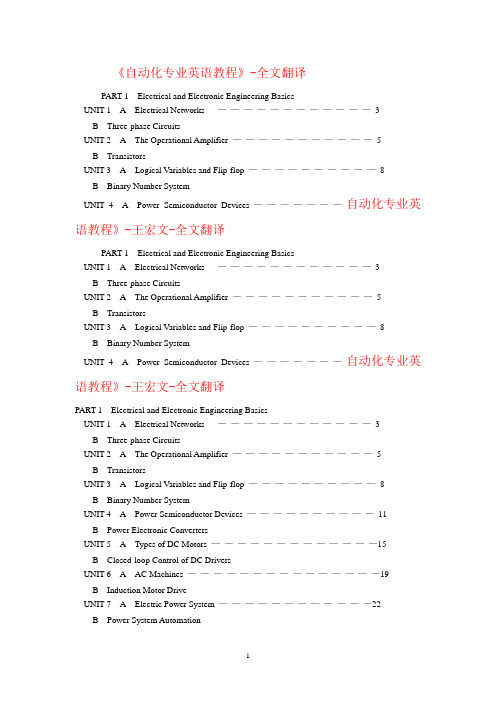
《自动化专业英语教程》-全文翻译PART 1Electrical and Electronic Engineering BasicsUNIT 1A Electrical Networks ————————————3B Three-phase CircuitsUNIT 2A The Operational Amplifier ———————————5B TransistorsUNIT 3A Logical Variables and Flip-flop ——————————8B Binary Number SystemUNIT 4A Power Semiconductor Devices ———————自动化专业英语教程》-王宏文-全文翻译PART 1Electrical and Electronic Engineering BasicsUNIT 1A Electrical Networks ————————————3B Three-phase CircuitsUNIT 2A The Operational Amplifier ———————————5B TransistorsUNIT 3A Logical Variables and Flip-flop ——————————8B Binary Number SystemUNIT 4A Power Semiconductor Devices ———————自动化专业英语教程》-王宏文-全文翻译PART 1Electrical and Electronic Engineering BasicsUNIT 1A Electrical Networks ————————————3B Three-phase CircuitsUNIT 2A The Operational Amplifier ———————————5B TransistorsUNIT 3A Logical Variables and Flip-flop ——————————8B Binary Number SystemUNIT 4A Power Semiconductor Devices ——————————11B Power Electronic ConvertersUNIT 5A Types of DC Motors —————————————15B Closed-loop Control of DC DriversUNIT 6A AC Machines ———————————————19B Induction Motor DriveUNIT 7A Electric Power System ————————————22B Power System AutomationPART 2Control TheoryUNIT 1A The World of Control ————————————27B The Transfer Function and the Laplace Transformation —————29 UNIT 2A Stability and the Time Response —————————30B Steady State—————————————————31 UNIT 3A The Root Locus —————————————32B The Frequency Response Methods: Nyquist Diagrams —————33 UNIT 4A The Frequency Response Methods: Bode Piots —————34B Nonlinear Control System 37UNIT 5 A Introduction to Modern Control Theory 38B State Equations 40UNIT 6 A Controllability, Observability, and StabilityB Optimum Control SystemsUNIT 7 A Conventional and Intelligent ControlB Artificial Neural NetworkPART 3 Computer Control TechnologyUNIT 1 A Computer Structure and Function 42B Fundamentals of Computer and Networks 43UNIT 2 A Interfaces to External Signals and Devices 44B The Applications of Computers 46UNIT 3 A PLC OverviewB PACs for Industrial Control, the Future of ControlUNIT 4 A Fundamentals of Single-chip Microcomputer 49B Understanding DSP and Its UsesUNIT 5 A A First Look at Embedded SystemsB Embedded Systems DesignPART 4 Process ControlUNIT 1 A A Process Control System 50B Fundamentals of Process Control 52UNIT 2 A Sensors and Transmitters 53B Final Control Elements and ControllersUNIT 3 A P Controllers and PI ControllersB PID Controllers and Other ControllersUNIT 4 A Indicating InstrumentsB Control PanelsPART 5 Control Based on Network and InformationUNIT 1 A Automation Networking Application AreasB Evolution of Control System ArchitectureUNIT 2 A Fundamental Issues in Networked Control SystemsB Stability of NCSs with Network-induced DelayUNIT 3 A Fundamentals of the Database SystemB Virtual Manufacturing—A Growing Trend in AutomationUNIT 4 A Concepts of Computer Integrated ManufacturingB Enterprise Resources Planning and BeyondPART 6 Synthetic Applications of Automatic TechnologyUNIT 1 A Recent Advances and Future Trends in Electrical Machine DriversB System Evolution in Intelligent BuildingsUNIT 2 A Industrial RobotB A General Introduction to Pattern RecognitionUNIT 3 A Renewable EnergyB Electric VehiclesUNIT 1A 电路电路或电网络由以某种方式连接的电阻器、电感器和电容器等元件组成。
自动化专业英语原文和翻译
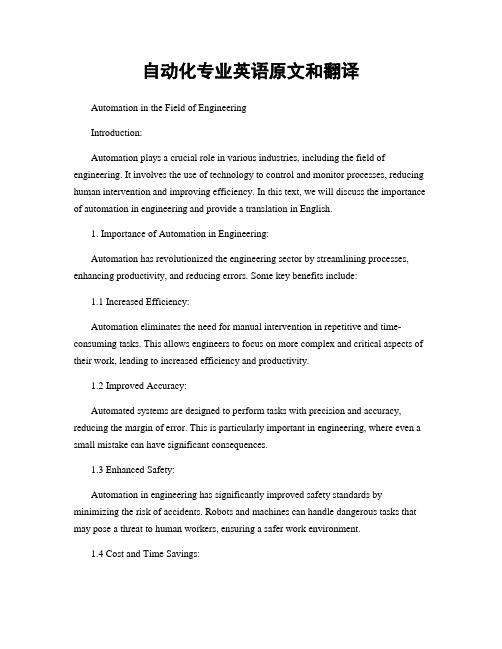
自动化专业英语原文和翻译Automation in the Field of EngineeringIntroduction:Automation plays a crucial role in various industries, including the field of engineering. It involves the use of technology to control and monitor processes, reducing human intervention and improving efficiency. In this text, we will discuss the importance of automation in engineering and provide a translation in English.1. Importance of Automation in Engineering:Automation has revolutionized the engineering sector by streamlining processes, enhancing productivity, and reducing errors. Some key benefits include:1.1 Increased Efficiency:Automation eliminates the need for manual intervention in repetitive and time-consuming tasks. This allows engineers to focus on more complex and critical aspects of their work, leading to increased efficiency and productivity.1.2 Improved Accuracy:Automated systems are designed to perform tasks with precision and accuracy, reducing the margin of error. This is particularly important in engineering, where even a small mistake can have significant consequences.1.3 Enhanced Safety:Automation in engineering has significantly improved safety standards by minimizing the risk of accidents. Robots and machines can handle dangerous tasks that may pose a threat to human workers, ensuring a safer work environment.1.4 Cost and Time Savings:By automating processes, engineering companies can reduce labor costs and save time. Automated systems can work continuously without breaks, leading to faster project completion and reduced operational expenses.2. Examples of Automation in Engineering:Automation is widely used in various branches of engineering. Here are a few examples:2.1 Manufacturing Automation:In the field of manufacturing, automation is extensively utilized to streamline production lines. Robots and computer-controlled machines are employed to carry out tasks such as assembly, welding, and quality control. This not only improves efficiency but also ensures consistent product quality.2.2 Process Automation:Process automation involves the use of control systems to monitor and regulate industrial processes. In engineering, this can include tasks such as temperature control, pressure regulation, and flow management. By automating these processes, engineers can optimize efficiency and ensure consistent output.2.3 Building Automation:Building automation systems are used to control and monitor various aspects of a building, such as lighting, HVAC (heating, ventilation, and air conditioning), and security. These systems improve energy efficiency, comfort, and security while reducing operational costs.2.4 Transportation Automation:Automation has greatly impacted the transportation sector, particularly in engineering fields such as automotive and aerospace. Automated assembly lines and robotic systems are used in vehicle manufacturing, while autopilot systems and advanced navigation technologies have revolutionized the aviation industry.3. Translation:自动化在工程领域的重要性引言:自动化在各个行业中都扮演着重要角色,其中包括工程领域。
自动化与电子信息专业英语教程(英文版)(ppt 72页)
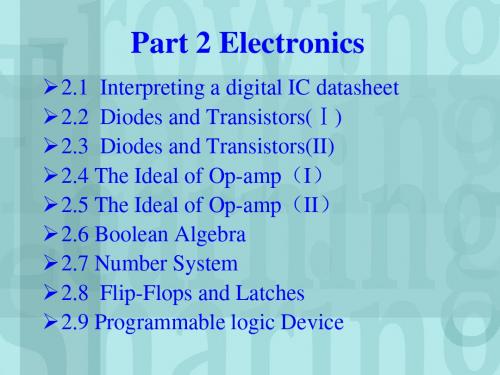
2.1 Interpreting a digital IC datasheet 2.2 Diodes and Transistors(Ⅰ) 2.3 Diodes and Transistors(II) 2.4 The Ideal of Op-amp(I) 2.5 The Ideal of Op-amp(II) 2.6 Boolean Algebra 2.7 Number System 2.8 Flip-Flops and Latches 2.9 Programmable logic Device
negative portion
负半周
full-wave bridge rectifier 全波桥式整流
transformers
变压器
in conjunction with
与…连接
bipolar junction
双极性
proportionality constant 比例常数
base
基极
collector
“in which” 引起 定语从句,修饰 “power supplies”
这是个典型主从复合句。
全句可译为“二极管的一个主要应用是 AC信号 整流,尤其是在某些需要将 AC 电转化为 DC 电的电源中。”
2.3 Diodes and Transistors(II)
2.3.2 Specialized English Words
本句结果较复杂,主句为“Saying that … beyond ” ,“Saying”为动名词作主语,它的宾 语为“that” 引导名词从句。 “means”为主语 “Saying …”的谓语动词,而“that its impedance…”为“means”的宾语从句,而这个从 句又有自己的结果状语“so that…” 。 全句可译为“我们说二极管在 以上导通的电流 无穷大实际上是指它的阻抗变得如此之小导致它 不再是电路中的限制因素。”
自动化专业英语原文和翻译
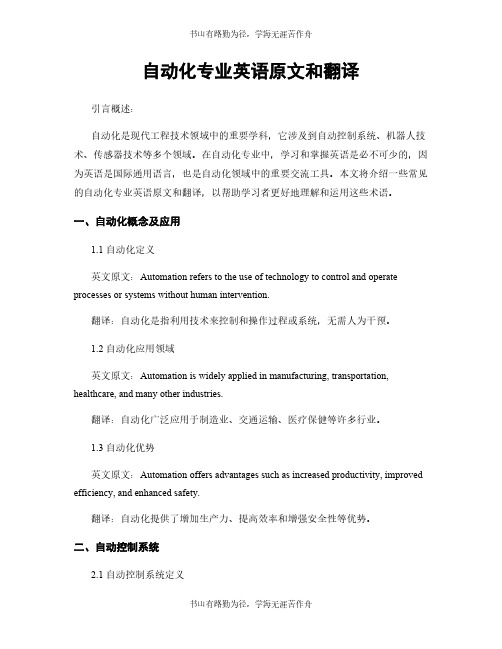
自动化专业英语原文和翻译引言概述:自动化是现代工程技术领域中的重要学科,它涉及到自动控制系统、机器人技术、传感器技术等多个领域。
在自动化专业中,学习和掌握英语是必不可少的,因为英语是国际通用语言,也是自动化领域中的重要交流工具。
本文将介绍一些常见的自动化专业英语原文和翻译,以帮助学习者更好地理解和运用这些术语。
一、自动化概念及应用1.1 自动化定义英文原文:Automation refers to the use of technology to control and operate processes or systems without human intervention.翻译:自动化是指利用技术来控制和操作过程或系统,无需人为干预。
1.2 自动化应用领域英文原文:Automation is widely applied in manufacturing, transportation, healthcare, and many other industries.翻译:自动化广泛应用于制造业、交通运输、医疗保健等许多行业。
1.3 自动化优势英文原文:Automation offers advantages such as increased productivity, improved efficiency, and enhanced safety.翻译:自动化提供了增加生产力、提高效率和增强安全性等优势。
二、自动控制系统2.1 自动控制系统定义英文原文:An automatic control system is a set of devices that manage and regulate the behavior of a system or process automatically.翻译:自动控制系统是一组设备,能够自动管理和调节系统或过程的行为。
2.2 自动控制系统组成英文原文:An automatic control system consists of sensors, actuators, controllers, and communication networks.翻译:自动控制系统由传感器、执行器、控制器和通信网络组成。
自动化专业英文P2U1英文全文带翻译课件

categories 类型 be characterized by ..的特点在于
Control theory itself has two categories:classical and modern.Classical control theory, which had its start during Word War II, can be characterized by the transfer function concept with analysis and design principally in the Laplace and frequency domains.
自动飞行控制系统把飞行员从保持正确航向、高度和姿 态的连续操作任务中解脱出来。没有了这些常规操作,飞 行员可以执行其他的任务,如领航或通讯,这样就减少了 所需的机组人员,降低了飞行费用。
intuition 直觉 commands 命令 disturbances 扰动
dynamic regulations
航向 姿态 机组人员
An autopilot(flight control system) relieves the pilot of the task of continuously operating the controls to maintain the desired heading, altitued, and atitude.Freed of this routine task,the pilot can perform other tasks,such as navigation and/or communications, thus reducing the number of crew required and consequently the operating cost of the aircarft
自动化专业英语教程(王宏文)第二版全文翻译
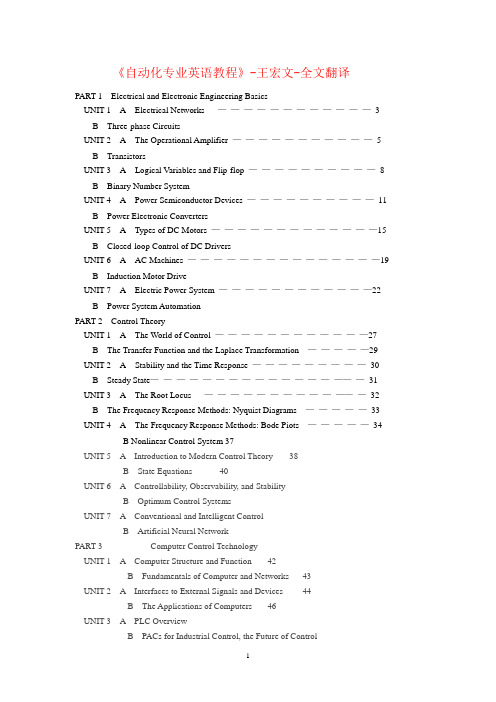
《自动化专业英语教程》-王宏文-全文翻译PART 1Electrical and Electronic Engineering BasicsUNIT 1A Electrical Networks ————————————3B Three-phase CircuitsUNIT 2A The Operational Amplifier ———————————5B TransistorsUNIT 3A Logical Variables and Flip-flop ——————————8B Binary Number SystemUNIT 4A Power Semiconductor Devices ——————————11B Power Electronic ConvertersUNIT 5A Types of DC Motors —————————————15B Closed-loop Control of DC DriversUNIT 6A AC Machines ———————————————19B Induction Motor DriveUNIT 7A Electric Power System ————————————22B Power System AutomationPART 2Control TheoryUNIT 1A The World of Control ————————————27B The Transfer Function and the Laplace Transformation —————29 UNIT 2A Stability and the Time Response —————————30B Steady State—————————————————31 UNIT 3A The Root Locus —————————————32B The Frequency Response Methods: Nyquist Diagrams —————33 UNIT 4A The Frequency Response Methods: Bode Piots —————34B Nonlinear Control System 37UNIT 5 A Introduction to Modern Control Theory 38B State Equations 40UNIT 6 A Controllability, Observability, and StabilityB Optimum Control SystemsUNIT 7 A Conventional and Intelligent ControlB Artificial Neural NetworkPART 3 Computer Control TechnologyUNIT 1 A Computer Structure and Function 42B Fundamentals of Computer and Networks 43UNIT 2 A Interfaces to External Signals and Devices 44B The Applications of Computers 46UNIT 3 A PLC OverviewB PACs for Industrial Control, the Future of ControlUNIT 4 A Fundamentals of Single-chip Microcomputer 49B Understanding DSP and Its UsesUNIT 5 A A First Look at Embedded SystemsB Embedded Systems DesignPART 4 Process ControlUNIT 1 A A Process Control System 50B Fundamentals of Process Control 52UNIT 2 A Sensors and Transmitters 53B Final Control Elements and ControllersUNIT 3 A P Controllers and PI ControllersB PID Controllers and Other ControllersUNIT 4 A Indicating InstrumentsB Control PanelsPART 5 Control Based on Network and InformationUNIT 1 A Automation Networking Application AreasB Evolution of Control System ArchitectureUNIT 2 A Fundamental Issues in Networked Control SystemsB Stability of NCSs with Network-induced DelayUNIT 3 A Fundamentals of the Database SystemB Virtual Manufacturing—A Growing Trend in AutomationUNIT 4 A Concepts of Computer Integrated ManufacturingB Enterprise Resources Planning and BeyondPART 6 Synthetic Applications of Automatic TechnologyUNIT 1 A Recent Advances and Future Trends in Electrical Machine DriversB System Evolution in Intelligent BuildingsUNIT 2 A Industrial RobotB A General Introduction to Pattern RecognitionUNIT 3 A Renewable EnergyB Electric VehiclesUNIT 1A 电路电路或电网络由以某种方式连接的电阻器、电感器和电容器等元件组成。
自动化专业英语王宏文全文翻译

自动化专业英语PART 1Electrical and Electronic Engineering BasicsUNIT 1A Electrical Networks —————- ————- —3B Three-phase CircuitsUNIT 2A The Operational Amplifier ———————————5B TransistorsUNIT 3A Logical Variables and Flip-flop —- ——- ——- ——8B Binary Number SystemUNIT 4A Power Semiconductor Devices ——- ——- ————11B Power Electronic ConvertersUNIT 5A Types of DC Motors - ————- - - ——- ——15B Closed—loop Control of DC DriversUNIT 6A AC Machines ———————- - ————- -19B Induction Motor DriveUNIT 7A Electric Power System - ————————- - —22B Power System AutomationPART 2Control TheoryUNIT 1A The World of Control ————————————27B The Transfer Function and the Laplace Transformation —————29 UNIT 2A Stability and the Time Response —————————30B Steady State——- ——- —- - —- ——- -—- 31UNIT 3A The Root Locus - ———- ——- ————- 32B The Frequency Response Methods:Nyquist Diagrams —————33 UNIT 4A The Frequency Response Methods:Bode Piots —- —- —34B Nonlinear Control System 37UNIT 5 A Introduction to Modern Control Theory 38B State Equations 40UNIT 6 A Controllability,Observability,and StabilityB Optimum Control SystemsUNIT 7 A Conventional and Intelligent ControlB Artificial Neural NetworkPART 3 Computer Control TechnologyUNIT 1 A Computer Structure and Function 42B Fundamentals of Computer and Networks 43UNIT 2 A Interfaces to External Signals and Devices 44B The Applications of Computers 46UNIT 3 A PLC OverviewB PACs for Industrial Control, the Future of ControlUNIT 4 A Fundamentals of Single-chip Microcomputer 49B Understanding DSP and Its UsesUNIT 5 A A First Look at Embedded SystemsB Embedded Systems DesignPART 4 Process ControlUNIT 1 A A Process Control System 50B Fundamentals of Process Control 52UNIT 2 A Sensors and Transmitters 53B Final Control Elements and ControllersUNIT 3 A P Controllers and PI ControllersB PID Controllers and Other ControllersUNIT 4 A Indicating InstrumentsB Control PanelsPART 5 Control Based on Network and InformationUNIT 1 A Automation Networking Application AreasB Evolution of Control System ArchitectureUNIT 2 A Fundamental Issues in Networked Control SystemsB Stability of NCSs with Network—induced DelayUNIT 3 A Fundamentals of the Database SystemB Virtual Manufacturing—A Growing Trend in AutomationUNIT 4 A Concepts of Computer Integrated ManufacturingB Enterprise Resources Planning and BeyondPART 6 Synthetic Applications of Automatic TechnologyUNIT 1 A Recent Advances and Future Trends in Electrical Machine DriversB System Evolution in Intelligent BuildingsUNIT 2 A Industrial RobotB A General Introduction to Pattern RecognitionUNIT 3 A Renewable EnergyB Electric VehiclesUNIT 1A 电路电路或电网络由以某种方式连接的电阻器、电感器和电容器等元件组成.如果网络不包含能源,如电池或发电机,那么就被称作无源网络.换句话说,如果存在一个或多个能源,那么组合的结果为有源网络.在研究电网络的特性时,我们感兴趣的是确定电路中的电压和电流。
2电气自动化专业英语翻译中文译文课后答案(李久胜马洪飞陈宏钧
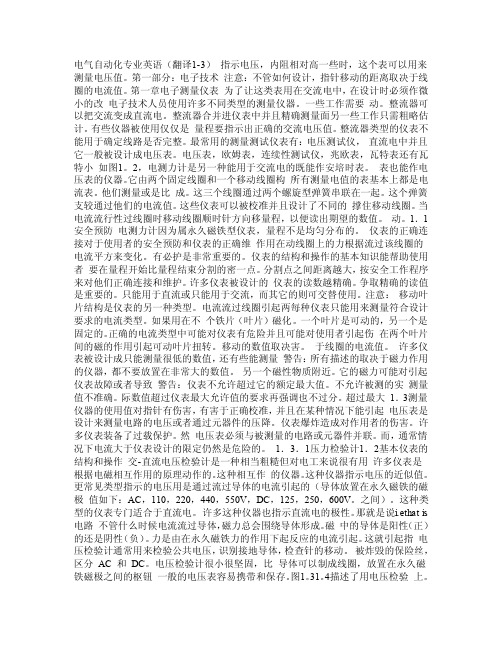
电气自动化专业英语(翻译1-3)指示电压,内阻相对高一些时,这个表可以用来测量电压值。
第一部分:电子技术注意:不管如何设计,指针移动的距离取决于线圈的电流值。
第一章电子测量仪表为了让这类表用在交流电中,在设计时必须作微小的改电子技术人员使用许多不同类型的测量仪器。
一些工作需要动。
整流器可以把交流变成直流电。
整流器合并进仪表中并且精确测量面另一些工作只需粗略估计。
有些仪器被使用仅仅是量程要指示出正确的交流电压值。
整流器类型的仪表不能用于确定线路是否完整。
最常用的测量测试仪表有:电压测试仪,直流电中并且它一般被设计成电压表。
电压表,欧姆表,连续性测试仪,兆欧表,瓦特表还有瓦特小如图1。
2,电测力计是另一种能用于交流电的既能作安培时表。
表也能作电压表的仪器。
它由两个固定线圈和一个移动线圈构所有测量电值的表基本上都是电流表。
他们测量或是比成。
这三个线圈通过两个螺旋型弹簧串联在一起。
这个弹簧支较通过他们的电流值。
这些仪表可以被校准并且设计了不同的撑住移动线圈。
当电流流行性过线圈时移动线圈顺时针方向移量程,以便读出期望的数值。
动。
1.1安全预防电测力计因为属永久磁铁型仪表,量程不是均匀分布的。
仪表的正确连接对于使用者的安全预防和仪表的正确维作用在动线圈上的力根据流过该线圈的电流平方来变化。
有必护是非常重要的。
仪表的结构和操作的基本知识能帮助使用者要在量程开始比量程结束分割的密一点。
分割点之间距离越大,按安全工作程序来对他们正确连接和维护。
许多仪表被设计的仪表的读数越精确。
争取精确的读值是重要的。
只能用于直流或只能用于交流,而其它的则可交替使用。
注意:移动叶片结构是仪表的另一种类型。
电流流过线圈引起两每种仪表只能用来测量符合设计要求的电流类型。
如果用在不个铁片(叶片)磁化。
一个叶片是可动的,另一个是固定的。
正确的电流类型中可能对仪表有危险并且可能对使用者引起伤在两个叶片间的磁的作用引起可动叶片扭转。
移动的数值取决害。
自动化专业英语unit 2 A1
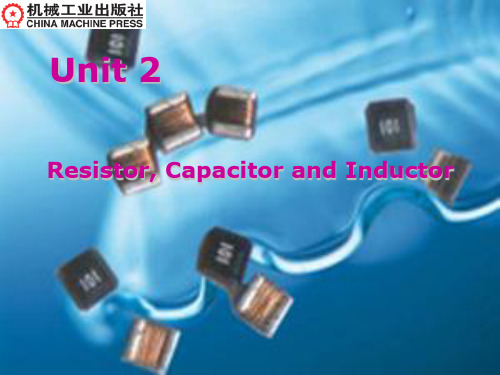
电容器储存电能的能力叫电容。电容器的电容量与介质的介电常数及
平板的面积成正比,与平板间的距离成反比,其大小用法拉表示。当电容 器两端的电压以每秒1伏的速率变化,产生的电流为1安培,就称电容器的 电容量为1法拉。在无线电方面的计算中,法拉的单位太大,因此常用微法 (法拉)和皮法(法拉)。
第
7 / 64页
Resistor, Capacitor and Inductor
Unit 2 Resistor, Capacitor
and Inductor
自动化专业英语
Inductor
lnductors consist of a conducting wire wound into the form of a coil. When a current passes through the coil, a magnetic field is set up around it that tends to oppose rapid changes in current intensity. All coils have inductance. A coil of many turns will have more inductance than one of few turns. Also if a coil is placed on an iron core its inductance will be greater than it was without the magnetic core. The unit of induct电感 电感是由绕成线圈形状的导线组成。当电流通过线圈时,在线圈周围 将产生磁场,它将阻止电流的快速变化。一切线圈,都有电感。 匝数多的线圈比匝数少的线圈电感更大。而且,假若线圈中放一个铁 芯它的电感将比没有铁芯的线圈的电感更大。
- 1、下载文档前请自行甄别文档内容的完整性,平台不提供额外的编辑、内容补充、找答案等附加服务。
- 2、"仅部分预览"的文档,不可在线预览部分如存在完整性等问题,可反馈申请退款(可完整预览的文档不适用该条件!)。
- 3、如文档侵犯您的权益,请联系客服反馈,我们会尽快为您处理(人工客服工作时间:9:00-18:30)。
这里fss是f(t)的稳态值。
4. 平移定理:第一个平移定理表明
或
式(2-1B-6)表示在拉氏域内移动a个单位,变换后在时域内得到e-a倍。第二个平移定理表明
这个定理在对延迟的输入和信号如传输滞后和由分析函数表示的连续输入很有用。
建模
分析技术需要数学模型。对于具有有限数目微分方程和用方块图代数表示的时不变线性系统的分析和设计,传递函数是一种方便的模型形式。从描述一个特定对象、过程或元件的微分或积分-微分方程,运用拉氏方程及其性质可以得到传递函数。
确定系统和随机系统:一个系统或变量,如果其未来的性能在合理的限度内是可预测和重复的,则这个系统或变量就是确定的。否则,系统或变量就是随机的。对随机系统或有随机
输入的确定系统的分析是基于概率论基础上的。
单变量和多变量系统:单变量系统被定义为对于一个参考或命令输入只有一个输出的系统,经常被称为单输入单输出(SISO)系统。多变量(MIMO)系统含有任意多个输入和输出。
此传递函数的定义要求系统是线性的和非时变的,具有连续变量和零起始条件。传递函数最适用于系统是集中参数和当传输延迟不存在或可忽略的情况。在这种条件下,传递函数本身可表示为拉普拉斯复数变量s的两个多项式的比值:
对于物理系统,由于系统特性是积分而不是微分,所以N(s)的阶次比D(s)要低。后面我们将看到用于频域的频率传递函数,它是通过把传递函数中拉普拉斯变量s用j?t代换得到的。
我们可以通过一个简单的例子说明:
图中输出电压uc由输入电压u激励。根据基尔霍夫定律,二者关系可写为下式
运用定理,零初始条件的变换方程如下
求解变换输出与输入的比,即得到系统的传递函数
式(2-1B-4)的定义可用来找到我们最常见和用到的函数的拉氏变换。为了方便,我们过去常建一个变换对的表,用于简化拉氏域变换和反变换。
这里有几条拉氏变换的定理和性质,它们既必需也很有帮助。
1.线性和叠加:
式中c和ci都是常数。
2. 微分和积分定理:对时间导数的拉氏变换可写为
式中f(0), df(0), 等是初始条件。如果初始条件为零,正如控制系统分析和设计的一般情况,最后的方程可缩减为:
积分的拉氏变换是
初始条件为零,它也可缩减为F(s)/s。
3. 初值和终值定理:初值定理表述为
在进行拉氏反变换时有用处。终值定理表述为
在特定的输入下,它决定每一暂态模式的大小和符号,从而确定暂态响应的图形和输出的稳态值。
对于一个闭环系统,其传递函数为:
式中W(s)为闭环传递函数,G(s)H(s)称为开环传递函数,1+G(s)H(s)是特征函数。
传递函数可以通过多种方法求得。一种方法是纯数学的,先对描述元件或系统的微分方程取拉普拉斯变换,然后求解得出传递函数。当存在非零起始条件时将之看作外加输入对待。第二种方法是试验法。通过给系统加上已知的输入,测出输出值,通过整理数据和曲线得出传递函数。某子系统或整个系统的传递函数经常通过对已知的单个元件传递函数的正确合并而得到。这种合并或化简称做方块图代数。
控制系统工程设计问题
控制系统工程由控制结构的分析和实际组成。分析是对所存在的系统性能的研究,设计问题是对系统部件的一种选择和安排从而实现特定的任务。控制系统的设计并不是一个精确或严格确定的过程,而是一系列相关事情的序列,典型的顺序是:
1)被控对象的建模;2)系统模型的线性化;3)系统的动态分析;4)系统的非线性仿真;5)控制思想和方法的建立;6)性能指标的选择;7)控制器的设计;8)整个系统的动态分析;9)整个系统的非线性仿真;10)所用硬件的选择;
拉普拉斯变换
拉氏变换源于工程数学领域,广泛用于线性系统的分析和设计。常系数的常微分方程转变为代数方程可通过传递函数的概念实现。此外,拉氏域更适合于工作,传递函数容易处理、修改和分析。设计人员很快就会熟练地把拉普拉斯域的变化与时域状态联系起来而不需真地解系统方程(时域)。当需要时域解时拉氏变换法可直接使用。解是全解,包括通解和特解,初始条件被自动包含在内。最后,可以很容易从拉氏域转到频域中去。
在很多情况下,控制系统的设计是基于某种理论,而不是靠直觉或试凑法。控制系统能够用来处理系统对命令、调节或扰动的动态响应。控制理论的应用基本上有两个方面:动态
响应分析和控制系统设计。系统分析关注的是命令、扰动和系统参数的变化对被控对象响应的决定作用。如某动态响应是满足需要的,就不需要第二步了。如果系统不能满足要求,而且不能改变被控对象,就需要进行系统设计,来选择使动态性能达到要求的控制元件。
控制理论本身分成两个部分:经典和现代。经典控制理论始于二次大战以传递函数的概念为特征,分析和设计主要在拉普拉斯域和频域内进行。现代控制理论是随着高速数字计算机的出现而发展起来的。它以状态变量的概念为特征,重点在于矩阵代数,分析和设计主要在时域。每种方法都有其优点和缺点,也各有其倡导者和反对者。
与现代控制理论相比,经典方法具有指导性的优点,它把重点很少放在数学技术上,而把更多重点放在物理理解上。而且在许多设计情况中,经典方法既简单也完全足够用。在那些更复杂的情况中,经典方法虽不能满足,但它的解可以对应用现代方法起辅助作用,而且可以对设计进行更完整和准确的检查。由于这些原因,后续的章节将详细地介绍经典控制理论。
线性和非线性系统:如果系统所有元件都是线性的,系统就是线性的。如果任何一个是非线性的,系统就是非线性的。
时变和时不变系统:一个时不变系统或静态系统,其参数不随时间变化。当提供一个输入时,时不变系统的输出不依赖于时间。描述系统的微分方程的系数为常数。如果有一个或多个参数随时间变化,则系统是时变或非静态系统提供输入的时间必须已知,微分方程的系数是随时间而变化的。
在式2-1B-2中,传递函数分母D(s)由于包含系统中所有的物理特征值而被称做特征方程。令D(s)等于0即得到特征方程。特征方程的解决定系统的稳定性和对任一输入下的暂态响应的一般特性。多项式N(s)是表示输入如何进入系统的函数。因而N(s)并不影响绝对稳定性或者暂态模式的数目和特性。
变换拉氏是从傅立叶积分演变而来,它定义为:
这里F(s)是f(t)的拉氏变换。相反,f(t)是F(s)反变换,它们之间的关系可由下式表达,
符号s表明拉氏变量是一个复数变量(?+j?)。因此,s有时表示复频,拉氏域称做复频域。
由于式(2-1B-4)的积分是不定积分,因此不是所有函数都可以进行拉氏变换。幸运的是,系统设计者感兴趣的函数通常都可以。拉氏变换的使用条件、理论证明和其他用途可见于工程数学的标准著作中。
11)开发系统的建立和测试;12)产品模型的设计;13)产品模型的测试。
这个顺序不是固定的,全包括的或必要次序的。这里给出为后续单元提出和讨论的技术做一个合理的阐述。
B 传递函数和拉普拉斯变换
传递函数的概念
如果像式2-1B-1表示的线性系统的输入输出关系已知,则系统的特性也可以知道。在拉普拉斯域表示的输入输出关系被称做传递函数。由定义,元件或系统的传递函数是经拉氏变换的输出与输入的比值:
A 控制的世界
简介
控制一词的含义一般是调节、指导或者命令。控制系统大量存在于我们周围。在最抽象的意义上说,每个物理对象都是一个控制系统。
控制系统被人们用来扩展自己的能力,补偿生理上的限制,或把自己从常规、单调的工作中解脱出来,或者用来节省开支。例如在现代航空器中,功率助推装置可以把飞行员的力量放大,从而克服巨大的空气阻力推动飞行控制翼面。飞行员的反应速度太慢,如果不附加阻尼偏航系统,飞行员就无法通过轻微阻尼的侧倾转向方式来驾驶飞机。自动飞行控制系统把飞行员从保持正确航向、高度和姿态的连续操作任务中解脱出来。没有了这些常规操作,飞行员可以执行其他的任务,如领航或通讯,这样就减少了所需的机组统:所有变量都是时间的连续函数的系统称做连续变量或模拟系统,描述的方程是微分方程。离散变量或数字系统有一个或多个只是在特殊时刻可知的变量,如图2-1A-2b,描述方程是差分方程。如果时间间隔是可控的,系统被称做数据采样系统。离散变量随机地产生,例如:为只能接受离散数据的数字计算机提供一个输入。显然,当采样间隔减小时,离散变量就接近一个连续变量。不连续的变量,如图2-1A-2c所示,出现在开关或乓-乓控制系统中。这将分别在后续的章节中讨论。
控制系统的分类和术语
控制系统可根据系统本身或其参量进行分类:
开环和闭环系统(如图2-1A-1):开环控制系统是控制行为与输出无关的系统。而闭环系统,其被控对象的输入在某种程度上依赖于实际的输出。因为输出以由反馈元件决定的一种函数形式反馈回来,然后被输入减去。闭环系统通常是指负反馈系统或简称为反馈系统。
